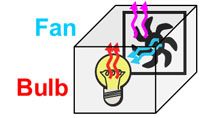Heat Transfer Using Finite Element Method in MATLAB | Finite Element Analysis in MATLAB, Part 2
From the series: Finite Element Analysis in MATLAB
Heat transfer refers to the flow of thermal energy due to differences in the temperature of objects. One of the most popular approaches for doing heat transfer analysis is using the finite element method (FEM). Learn how to solve heat transfer problems using the finite element method with Partial Differential Equation Toolbox™ in MATLAB®. You can also take it one step further and address thermal management challenges by exploring and optimizing your design using design of experiment and optimization techniques.
Published: 22 Sep 2020
In this video you will learn how to analyze heat transfer using finite element method with partial differential equation toolbox in MATLAB. To quickly recap, in a previous video, we saw how the turbine blades of a jet engine a surrounded by gases under extremely high temperatures and pressures the blade material both expands and deforms significantly, producing mechanical stress in the joints in significant deformations of several millimeters. To avoid mechanical failure and friction between the tip of the blade and the turbine casing, the blade designed must account for this stress and deformations. Let us now learn how to do this in MATLAB. To perform an FEA in MATLAB, we start by creating a model object using the createPDE command. To analyze the heat transfer, we indicate the analysis type thermal in the first argument. We then specify that the analysis should be performed under steady state conditions. The PDE toolbox supports various other types of analysis, such as transient, steady state, axisymmetric etc. We will be using the model object later on to set up the analysis. In a typical finite element analysis workflow, we go through four steps. Import or create the geometry. Preprocess the geometry. Solve the model post process the results. After defining the analysis type, we begin with the first step of the analysis, imposed the geometry of the blade model from an STL file. We can then generate a mesh for the geometry of the blade. We then define the physics of the problem. As in the last example, the model does not contain any information regarding the material of the blade. In this example, the blade is made of a nickel-based alloy Nimonic 90. The specific thermal conductivity of this alloy represented by Kappa, which is a measure of his ability to conduct heat, is of importance for this analysis. We then use the thermalProperties command, set the material properties of tmodel and specify Kappa as the thermal conductivity. The convective heat transfer between the surrounding gases and the faces of the blade defines the boundary conditions for this problem. This process is encoded by a set of boundary conditions for each face of the blade. The convection coefficient, which is directly proportional to the gas velocity and the ambient gas temperature. There are interior cooling ducts in the blade marked by faces 12, 14 and 15, which are represented by the hole passing through the center of the turbine blade. The cool air flowing through the duct maintains the temperature of the blade within the limit for its material. This feature is common in modern blades. The temperature of the internal cooling air can be expressed as a thermal boundary condition on the model using the thermal BC function. The convection coefficient is set to 30 while the ambient temperature is set to 150 degrees centigrade. Smaller boundary conditions can be set for the interactions of the other face of the blade and the surrounding gases. The pressure side boundary condition of the blade is defined by a convection coefficient of 50. While the temperature of the ambient gases is 1000 degrees Celsius, whereas the suction side faces a lower convection coefficient of 40. With the same ambient temperature. The tip of the blade has a convection coefficient of 20 due to lower gas speed. While the ambient temperature is still 1000 degrees Celsius. The base of the blade is exposed to hot gases at a lower temperature, but higher gas velocity than the tip, for a convection coefficient of 40 and an ambient temperature of 800 degrees Celsius. The root of the blade also faces hot gases, a lower convection coefficient of 15 and a lower ambient temperature of 400 degrees Celsius. We can also model the face in contact with the radial axis metal as convection with a very large coefficient around 1000. The ambient gas temperature is lower at 300 degrees Celsius. Finally, we solve the problem using the solve command. We can then post process the results and visualize them. The pdeplot3D command can then be used to visualize the temperature distribution of the blade. Here we are looking at the blade temperature at various points. The temperature between the tip and the root ranges from 820 degrees Celsius to 330 degrees Celsius. The exterior gas temperature is 1000 degrees Celsius. The internal cooling is sufficient. It significantly lowers the temperature once the model is built, you may want to explore the design space using design of experiment techniques. Or by simply doing parameter sweeps. Please check out the statistics and machine learning toolbox for more information. You may also want to optimize your design for specific conditions or find the best material to be used for specific applications. In the video we just covered, you learn how to analyze heat transfer using finite element method with partial differential equation toolbox in MATLAB. To learn more about using the PD toolbox for various types of analysis, please refer to the PDE toolbox home page and the examples on the documentation page. Don't forget to check out the links in the video description. Thank you for watching.




